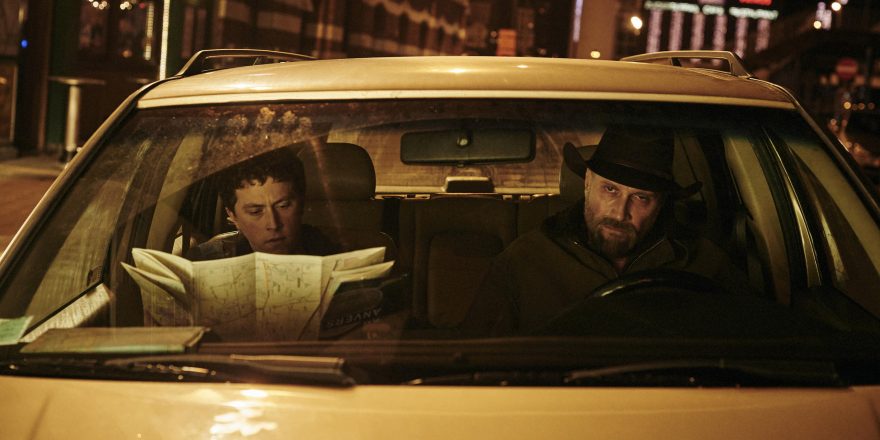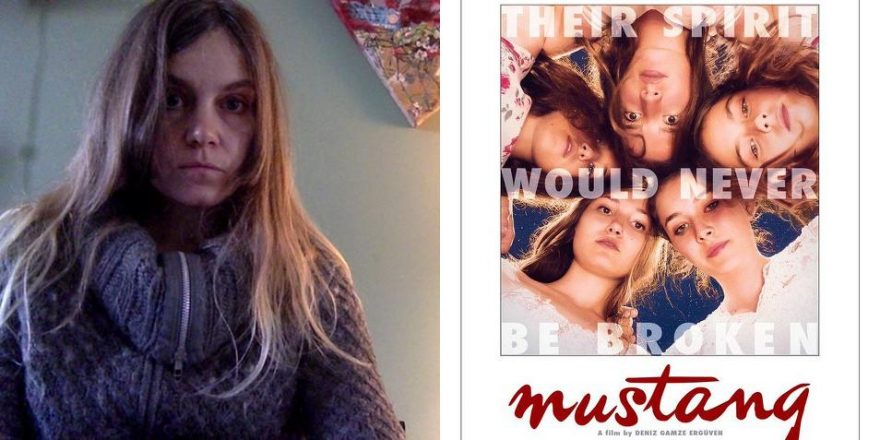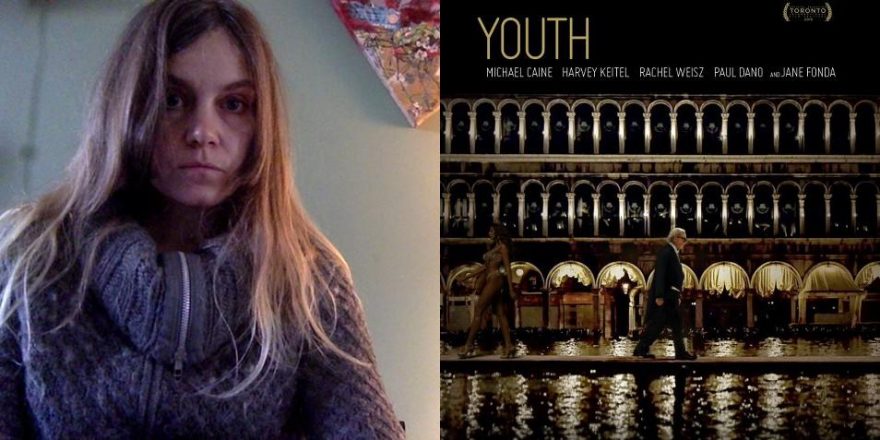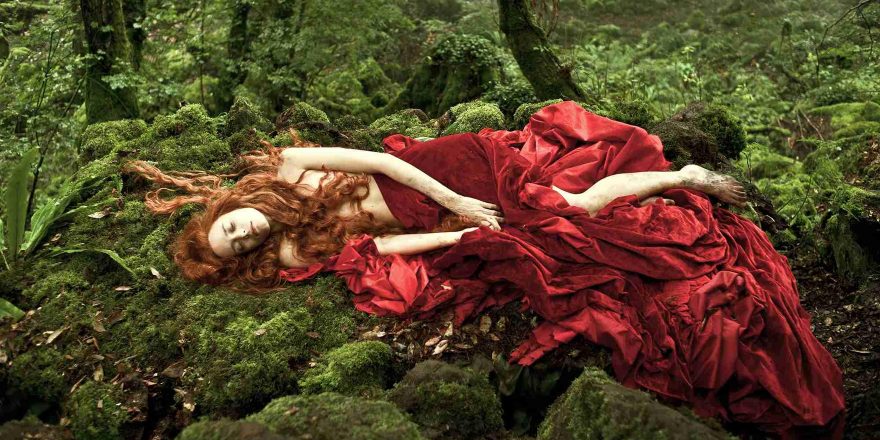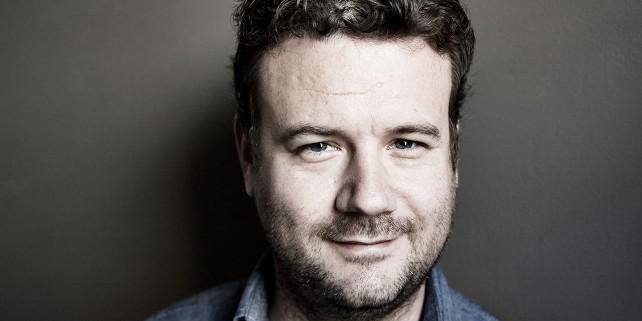The man on the screen wears a cowboy hat, cowboy boots and a jean jacket. His family is with him. The son buttons up his jean jacket. American flags wave in the background. A Confederate flag waves further away. The man is Alain Balland, played by François Damiens. He gestures to his family and says, “Let’s go.” But the words are not delivered with the macho American voice you’d expect from a man with a cowboy hat. The line doesn’t come out of his mouth like it might from Robert Mitchum, Lee Marvin, Clint Eastwood or Henry Fonda. Instead, sexy, puffy, silk-threaded French words pass through his moisturized lips. It’s really weird seeing French guys play cowboys on a movie screen. The father ties a red bandanna around his daughter Kelly’s neck. He helps her with a costume we’re unaccustomed to seeing in a French landscape. He’s helping her to fit into this blatantly Western world. Kelly seems uninterested.
Kelly disappears during the festivities. As Alain is asking folks at the hoedown if they’ve seen her, I forget the cowboy is French. I accept the notion that a country which makes cream puffs and perfume can also have cowboys muscling bad guys around. The story begins.
At first, Alain thinks his daughter has been kidnapped. He finds a book of Arabic writing and evidence of a Muslim boyfriend. It is assumed that she left with this young man. His search begins with the local Muslims, but extends further. Alain searches the hideouts of terrorists, the countries that harbor terrorists, the homes that beget terrorists. He searches like a John Wayne character searching the teepees of the Comanche Indians. But you can’t find someone who doesn’t want to be found. Kelly wanted to escape her life. We follow the father on his endless search to find his daughter. Yet another characteristic of the cowboy is their relentlessness. They never quit. As I watch Alain ruin his own life in pursuit of his daughter, I wonder why his daughter left. This seems to be a reoccurring question these days. Why are young people running from Western homes and into Isis caves?
The opening shot of Les Cowboys is of an Indian. He raises his arms in front of the waterfalls like he’s raising the curtain to an old Hollywood genre. The Western. Where there were Indians there were also cowboys. Cowboys were good, Indians were bad. I was reminded of the childhood game Cowboys and Indians.
I don’t know if the rest of the world was playing it then, but on my American block we played Cowboys and Indians as children. We used sticks for bows and arrows, and bigger sticks for guns. There weren’t many rules. Usually the biggest kid was the leader. He would decide who were cowboys and who were Indians. Most kids begged to be cowboys. Cowboys were “cool.” Cowboys had guns. Cowboys might have hats, Indians headbands. Whoever had a tricycle had a horse. The cowboys often had a sheriff, while the Indians were usually leaderless and lawless. Then, we went to war. The cowboys stayed on the porch. The Indians broke out into the alleys. Both sides could take hostages, and we did. “Time out” might be called when someone bit someone else’s face. The fighters would disengage as an aunt came cursing down the steps, flicked her cigarette into the bush, grabbed the biter by her shirt and dragged her out of the game and into the house. Then the fight resumed. The game never ended. Peace was never made. We only stopped when Grandma yelled out, “Supper’s ready!”
What was Redskins and Palefaces not long ago, is now Infidels and Ragheads. Thomas Bidegain shows us in Les Cowboys that we are living in the wild frontier again. Except the weapons have gotten bigger, the destruction wider. We are living in a Hollywood Western. We are living in a deadly game.
A forger of documents for the Algerians says to the father, “You know how those savages treat women?” It sounds like a line from a 1950s Western. “Savages” are what Americans called the Native Americans. Now the “savages” are Muslims. We haven’t changed. We fear what we don’t know. We don’t know what it is we fear. Our behavior is the same. Their behavior is the same. The world is only a little bit different.
From what I remember watching TV with my grandpa, there was an awareness of the Native American’s experience being portrayed in Western programs. Indians were making friends with cowboys on Grizzly Adams, Bonanza and Little House on the Prairie. It took a couple hundred years to realize there was Good in our bad guys and Bad in our good guys. We were misinformed by the old Westerns. We believed Hollywood for a long time. When will we understand the Middle Eastern experience? When will we be truly informed?
As Alain’s son, Georges, takes over the search for his sister, we follow him into a world of sand and mountains. We sit with George under the wide open sky, riding on horseback, passing a “peace pipe.” These are the realities of the Middle East. These were the realities of our Wild West.
Just as we see Alain speaking French in a cowboy hat, we see Kelly covered by the Muslim burqa and hijab. These characters fill the roles that we don’t expect to see as audience members. This gave me hope. Once we start accepting that cowboys can speak French and blue-eyed girls can wear the hijab, then maybe we can accept each other for who we are rather than what we wear, or what god we follow, or how much territory we own. We might notice similarities between us that borders and religions can never deny.
There is another glimmer of hope in Les Cowboys when Alain’s son teaches his own son to make a bow. It’s the cowboy teaching his boy how to make the “enemy’s” weapon. It’s at least the beginning of understanding the other side.
I think about the war games my boys have played. They will always find a weapon. They found some sticks and shot each other once or twice. They had a few enemies, they had a few battles in outer space. The only hostage they held was a doll that wouldn’t close her eyes. They yelled at her and put her in a pretend oven. There’s been less and less killing in our house these days. They never knew Cowboys and Indians. For them, the game never existed.



